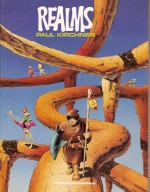
By Paul Kirchner (Catalan Communications)
ISBN: 0-87416-043-X ISBN-13: 978-0-87416-043-7
In the 1980s American comics got a huge creative boost with the advent of high quality magazines such as Heavy Metal and Epic Illustrated which showcased adult-oriented material with high quality graphics and formats such as had taken Europe by storm a decade earlier. Previous US experience of such work had been limited to the Underground Comix scene – in terms of content if not production values, at least – and the occasional independent experiment of such maverick luminaries as Wally Wood and Jim Steranko.
When Heavy Metal first launched in April 1977 (looking very much like its French conceptual “parent” Métal Hurlant, there was precious little original home-grown material to supplement the sumptuous continental work therein. One of the first creators to join the magazine was Paul Kirchner, who had worked as an assistant to Wally Wood in the early 1970s, contributing to such Woody-associated projects as Big Apple Comics.
Born in 1952, Kirchner was in his third year at Cooper Union School of Art in New York when Neal Adams and Larry Hama introduced him to the horror editors at DC, whose anthology titles always needed fresh blood. He assisted Tex Blaisdell on Little Orphan Annie and in 1973 joined Ralph Reese at Wood’s studio.
His starkly surreal strip The Bus debuted in Heavy Metal in 1978 and ran intermittently until 1985. During this time Kirchner was seeking something more meaningful for his creative energies and the tales collected in Realms (both colour and monochrome and all previously published in either HM or Epic) are the results of that search.
All the strips come from the period 1975-1986, and the book starts with a single-page pastiche of EC comics entitled ‘They Came From Uranus!’ before the main event begins with the fantasy quest ‘Tarot’, a meticulously rendered gem of magic, motorcycles and lost civilisations. ‘Shaman’ relates a duel in the spirit-lands between two Mexican Brujos (sort of wizards or wise-men) whilst the visually stunning ‘Hive’ examines two of life’s biggest puzzles: Work and Sex.
‘Mirror Dreams’ uses rogue Ronin and Shinto sages to examine the nature of reality, whilst ‘A Spirit of Thaxin’ utilises eye-watering black and white line, hatching and feathering to produce a sardonic tale of demonic servitude that owes much stylistically to the artist’s old boss Wally Wood.
Shorter monochrome vignettes close out the book, punchy little gags and vignettes with an adult sting in the tail. ‘The Temple of Karvul’, ‘Pillars of P-11507’, ‘Critical Mass of Cool’, ‘Survivors’, ‘My Room’ and ‘Judgement Day’ are a blend of surrealism, visual punning and broad satire that typified the best of Tharg’s Future Shocks from Britain’s 2000AD – and probably were intended for the same kind of reader.
As well as a successful career in toy and product design, Kirchner has worked for the New York Times, worked on licensed comics featuring RoboForce, He-Man, GoBots, ThunderCats, G.I. Joe, and Power Rangers and has produced occasional books as varied as Trajectories, Big Book of Bad, Big Book of Losers, and the seminal Murder by Remote Control written with Zen Buddhist Janwillem van de Wetering.
This early compendium is more indicative of the artist’s astounding drawing ability, but nevertheless still offers a refreshingly engaging spread of fun and fantasy for adult readers.
© 1987 Paul Kirchner. © 1987 Catalan Communications. All Rights Reserved.
